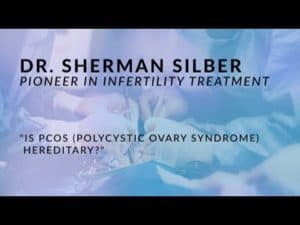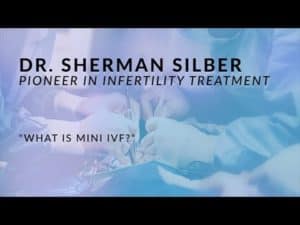How widespread is infertility? Is it usually a problem just of women?
An estimated one of every five American couples is infertile. But it is also a worldwide epidemic! For 40 percent of these couples, the inability to conceive stems from a problem with the man’s sperm. In 20 percent of infertile couples, both the man and woman have reproductive difficulties, and in the remaining 40 percent the man is fully fertile but the woman is not.
What is the reason for this burgeoning epidemic?
The most significant cause of the widespread infertility epidemic is that women are waiting longer to have children. A woman’s fertility decreases between the ages of 20 and 35, and then dramatically drops thereafter. In men, poor sperm production is usually genetic in origin and is also on the rise due to spontaneous mutations.
How is it that women in menopause are now getting pregnant?
Provided that a proper lining of the womb is created (through hormone treatment) a woman can get pregnant, carry, and deliver a baby at virtually any age using donor eggs from a younger woman. However, as a woman gets older, even before menopause, the likelihood that she can produce eggs capable of resulting in a baby decreases significantly. So donor eggs may also be required for these women also. A new solution for the young woman who does not anticipate starting a family for many years, but who wants her own genetic child, is ovarian tissue freezing.
What should couples consider other than IVF?
Many couples want to know about simple treatments. They might wind up spending 5 or 10,000 dollars on IUIs, which is a waste of money. They’ll usually go to the health food store and buy all kinds of dietary supplements, because if something costs $39.95 or $59.95, they figure, let’s try it. But none of them are really effective and some of them can actually be harmful because they might put estrogen or testosterone in them just to get some kind of an impact or an effect.
The best advice I can give is if you are young and you really don’t want to go into IVF, is to avoid the advice that you’re getting everywhere about timing intercourse. These ovulation kits are not very accurate and very frequently you’ll wind up having your intercourse after you’ve ovulated and the egg is no good eight hours after it’s ovulated. You always want sperm in the reproductive tract of the female and the sperm will last and be good for two to three days. So I tell people, “Don’t try to time when you have sex. It does no good. Strive to have a healthy marital sex life and that usually turns out to be two or three times a week on average. That two to three times a week means there will always be viable sperm in the tract for whenever you ovulate. Dr. Silber believes that is the most important practical advice he can give short of technical treatment.
Does a low or zero sperm count make fertilization and pregnancy even with IVF impossible
A normal sperm count offers the best chance for natural conception, because only a small percentage of millions of sperm in the ejaculate reach the fallopian tube, where the egg can be fertilized. Drug treatments and varicocele operations designed to increase sperm count, in truth do not have any beneficial effect. However, ICSI for the lowest sperm counts, and sperm extraction with ICSI for “zero” sperm, now give pregnancy rates with IVF no different than in men with normal sperm counts.
Does adding these newer technologies to IVF substantially increase the cost of treatment?
Studies of children resulting from assisted reproductive technologies have not validated such concerns, despite the fears of some critics of the procedures. Dr. Silber has contributed to follow-up study of such children. More than 1,000 children born as a result of ICSI have demonstrated no increase in risk of genetic or congenital abnormalities.
When the ICSI procedure was first developed in 1993, critics feared that the men’s “abnormal” sperm might produce abnormal babies. However, the children show no greater incidence of chromosomal or congenital abnormality than is present in the general population. Also, the emotional stability and competence levels of these children tend to be above average – possibly, Dr. Silber believes, because of dedicated parenting from men and women who were eager to become parents.
Are children born as a result of IVF and other assisted reproductive technologies at high risk of genetic abnormality or developmental problems?
Microsurgical techniques offer very good chances for restoring fertility after sterilization – even if other attempts have failed. Microscopic surgery should give over 90% restoration of fertility after vasectomy reversal, and up to 100% restoration of fertility with tubal ligation reversal. Forty percent of Dr. Silber’s vasectomy reversal patients come to him after having had failed vasectomy reversals elsewhere. The microscopic vasectomy reversal procedure that he developed – and has used on more than 6,000 patients – utilizes separate suturing in reconnecting the outer layer of the vas deferens and the delicate inner layer, which is only about 3 cells thick. Less precise methods may allow leakage of sperm from the inner layer of the vas at the reconnection site. Such leakage can result in sperm counts that are too low for natural fertilization. But a precise reversal operation restores fertility to most men.
If large portions of their fallopian tubes were destroyed by the ligation procedure, women undergoing tubal ligation reversals have less chance of success in restoring fertility. However, in most instances this is not a problem, and almost all women can have their fertility restored. Less precise, non-microscopic surgical methods may leave a less smooth reconnection site in each fallopian tube – increasing chances of an ectopic pregnancy, or implantation of an embryo in the tube instead of the uterus.
Do vasectomies and tubal ligations results in permanent and irreversible sterilization?
Microsurgical techniques offer very good chances for restoring fertility after sterilization – even if other attempts have failed. Microscopic surgery should give over 90% restoration of fertility after vasectomy reversal, and up to 100% restoration of fertility with tubal ligation reversal. Forty percent of Dr. Silber’s vasectomy reversal patients come to him after having had failed vasectomy reversals elsewhere. The microscopic vasectomy reversal procedure that he developed – and has used on more than 6,000 patients – utilizes separate suturing in reconnecting the outer layer of the vas deferens and the delicate inner layer, which is only about 3 cells thick. Less precise methods may allow leakage of sperm from the inner layer of the vas at the reconnection site. Such leakage can result in sperm counts that are too low for natural fertilization. But a precise reversal operation restores fertility to most men.
If large portions of their fallopian tubes were destroyed by the ligation procedure, women undergoing tubal ligation reversals have less chance of success in restoring fertility. However, in most instances this is not a problem, and almost all women can have their fertility restored. Less precise, non-microscopic surgical methods may leave a less smooth reconnection site in each fallopian tube – increasing chances of an ectopic pregnancy, or implantation of an embryo in the tube instead of the uterus.
Is vasectomy reversal unlikely to be effective if a great deal of time has passed since the vasectomy or if much of the vas deferens has been removed?
Even if a large portion of the vas was destroyed in the vasectomy, or if more than 20 years has passed since the vasectomy, microscopic surgery (if properly performed) will restore fertility in most cases. Large gaps can be bridged with no difficulty by simply freeing up a greater length of vas.
The biggest problem (which can be solved) is that pressure from sperm build-up usually causes damage to the “epididymis,” which drains sperm from the testicle into the vas. Even in these difficult patients, 90 percent recover fertility with a proper microsurgical “epididymal” bypass.











